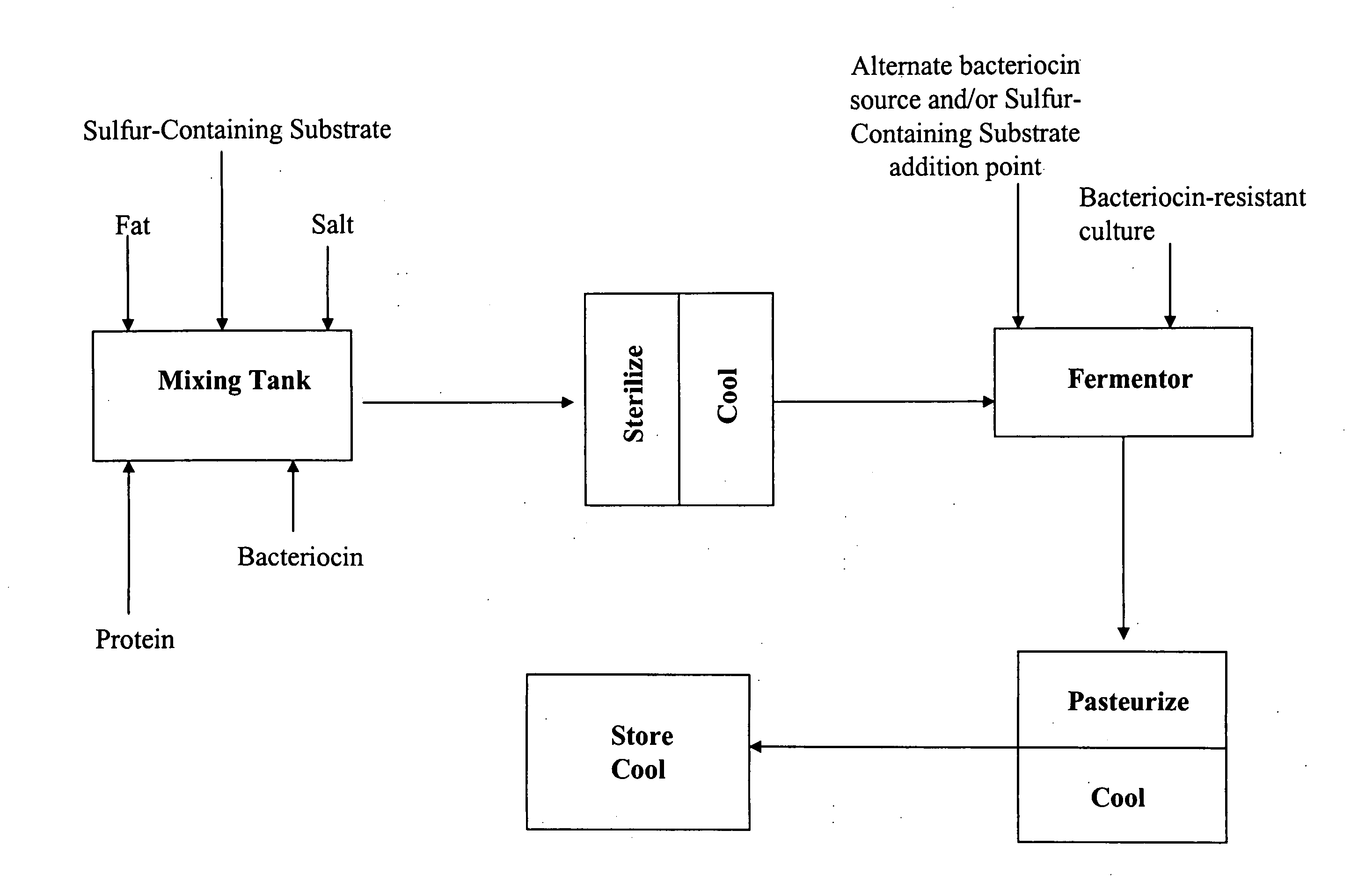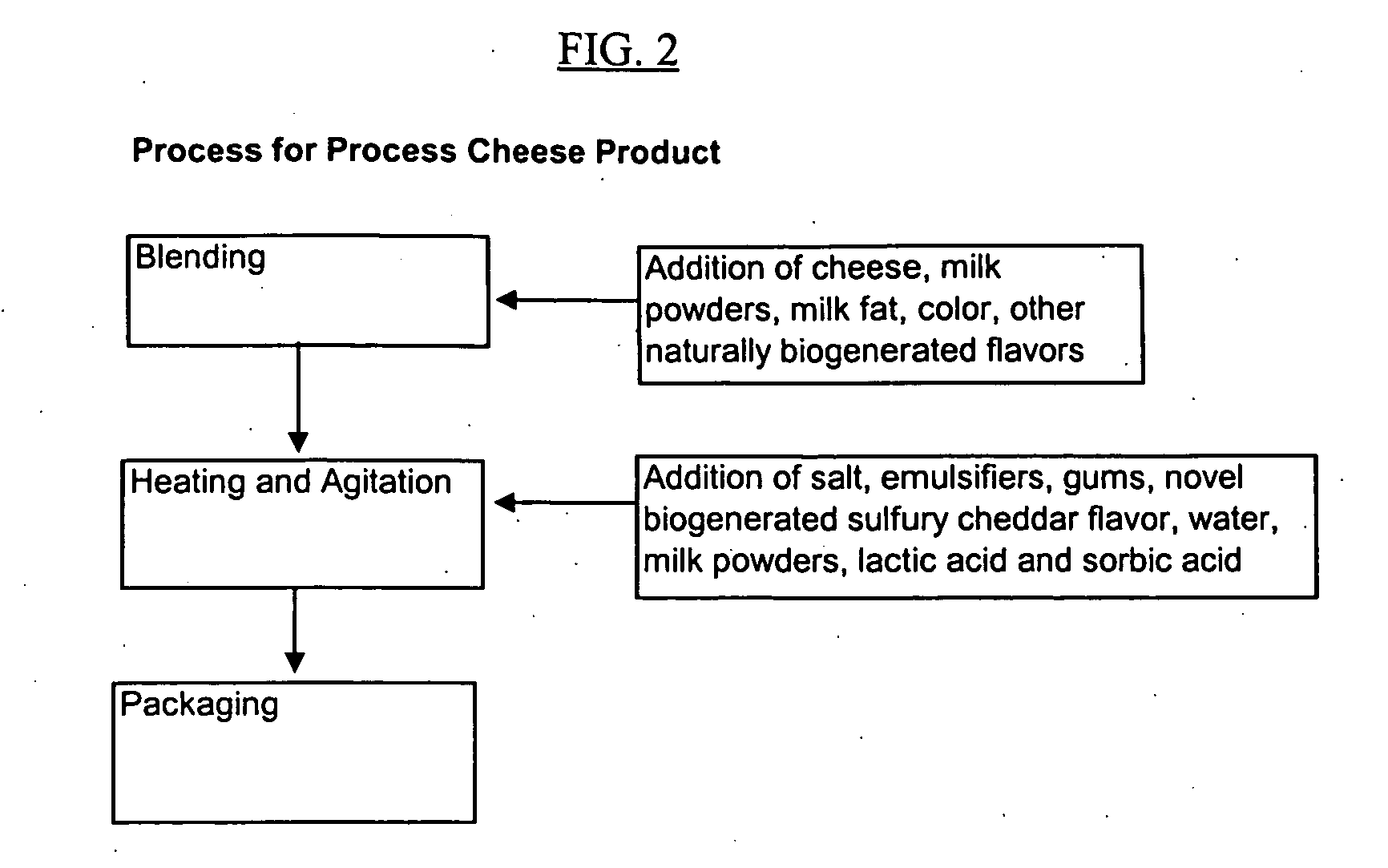Methods for rapid production and usage of biogenerated flavors
a bio-generated cheese and flavor technology, applied in milk preparation, food preparation, food science, etc., can solve the problems of not producing enhancements that target specific cheese flavor components, processed block cheese and processed cheese spreads are vulnerable to spoilage by germination, etc., to accelerate fermentation time, accelerate fermentation time, and develop the flavor quickly
- Summary
- Abstract
- Description
- Claims
- Application Information
AI Technical Summary
Benefits of technology
Problems solved by technology
Method used
Image
Examples
example 1
[0067] This example illustrates the preparation of a rapidly produced cheddar type component as a flavor concentrate. A first mixture is prepared by combining 42 percent fat sweet cream (90 percent of formula and the primary lipid and protein source), non-fat dry milk (2 percent of formula), sodium chloride (8 percent of formula), L-methionine (0.2 percent of formula), and NISAPLIN® from Danisco (0.015 percent of formula). The resulting first mixture is 48 percent moisture, 39 percent fat, 2.5 percent protein and has a pH of 6.0. The resulting first mixture is then high temperature heat treated at 122° C. for 30 seconds by direct steam injection, and then is cooled to 25° C. The resulting intermediate product is used to prepare the specific flavoring components of these examples using a single-stage fermentation procedure.
[0068]Brevibacterium linens ATCC No. 9174 is obtained from American Type Culture Collection. This strain was made nisin resistant by sequentially growing it in tr...
example 2
[0071] As shown in FIG. 2, a processed cheese is prepared using the flavor component prepared according to Example 1. A mixture containing 25 pounds cheddar cheese, 49 pounds water, 18 pounds naturally biogenerated cheese flavor (as described in U.S. Pat. No. 6,406,724 and incorporated herein), 2 pounds enzyme modified fresh cheese (as described in U.S. Pat. No. 6,251,445 and incorporated herein), 18 pounds milk fat, 0.1 pounds cheese color, 42 pounds milk protein concentrate, 13 pounds whey protein concentrate, and 3 pounds calcium phosphate are combined to form a pre-blend. Approximately 47 pounds of the pre-blend, 0.1 pounds sorbic acid, 2 pounds emulsifying salts, 1 pound sodium chloride, and 0.1 pounds sodium alginate are added to the steam injected processor under agitation. Next the flavor component of Example 1 is added at 1 pound. The product is heated to 74° C. and held for 60 seconds. Then, 7 pounds water, 1 pounds dry whey, 2 pounds milk protein concentrate and 4 pounds ...
example 3
[0072] As shown in FIG. 3, a dry cheese powder is produced using the cheddar flavor component produced according to Example 1. A blend containing 20 pounds soft, unripened cheese, 4 pounds enzyme-modified cheeses, and 1 pound cheddar flavor component produced according to Example 1 is added to the steam injected processor under agitation. Next, 1 pounds sodium chloride, 2 pounds emulsifying salts, and 1 pound calcium salt are added to the processor. The mixture is heated to 79° C. and then 0.1 pounds color, 30 pounds dry whey, 25 pounds water, and 1 pound citric acid are added to the mixture. The blend is heated to 88° C. and held for 120 seconds. The mixture is spray dried before packaging.
PUM
 Login to View More
Login to View More Abstract
Description
Claims
Application Information
 Login to View More
Login to View More - R&D
- Intellectual Property
- Life Sciences
- Materials
- Tech Scout
- Unparalleled Data Quality
- Higher Quality Content
- 60% Fewer Hallucinations
Browse by: Latest US Patents, China's latest patents, Technical Efficacy Thesaurus, Application Domain, Technology Topic, Popular Technical Reports.
© 2025 PatSnap. All rights reserved.Legal|Privacy policy|Modern Slavery Act Transparency Statement|Sitemap|About US| Contact US: help@patsnap.com



